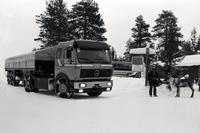25 Years of ABS For Commercial Vehicles: The Origins of Sophisticated Safety Engineering
*Debut in trucks, buses and coaches in 1981 thanks to Mercedes-Benz
*Decisive contribution to enhanced road safety
*Prerequisite for sophisticated safety systems such as ESP and ASR
Stuttgart, Feb 12, 2006: The time: late January 1981. The place: an icy airfield in the Arctic Circle. The occasion: a development team from the then Daimler-Benz AG is about to demonstrate the first production-ready antilock braking system for commercial vehicles. The demonstration proves an unqualified success: ABS allows evasive manoeuvres during emergency braking; it keeps trucks, buses and coaches safely on track when braking on non-uniform road surfaces (different friction coefficients beneath the left and right wheels); and it enables vastly improved control of trailers and semitrailers in critical situations thanks to the stability of the tractor unit. Available for Mercedes-Benz heavy-duty trucks, buses and coaches from autumn 1981, ABS quickly establishes itself as one of the most significant safety developments in automotive history. ABS development posed a major challenge
The pioneering role in the development and introduction of ABS was played by Daimler-Benz together with its development partner, the brake manufacturer Wabco. ABS presented the engineers with a series of extremely stiff challenges: different axle configurations, heavy weight, a significant difference between kerb weight and permitted gross vehicle weight, the variety of vehicle combinations and a large number of models, due to various wheelbase lengths and body types, resulted in a high degree of complexity.
The use of electronics was imperative: together with ABS, microcomputers for controlling the braking power were employed for the very first time. Before receiving the go-ahead for production, the anti-lock braking system for trucks, buses and coaches was tested over a total distance of more than 60 million kilometres, since ABS had to perform reliably under all conditions.
The trigger for a flood of innovations
Following its launch for commercial vehicles in 1981, ABS triggered a flood of active safety innovations, with the focus on braking systems in particular. Six years later acceleration skid control (ASR) arrived to complement ABS in trucks, buses and coaches. Put simply, ASR is the antithesis of ABS in terms of its control characteristics: whereas ABS precisely reduces the braking pressure on a locked-up wheel, ASR in effect does the opposite by braking a wheel which is spinning, thereby not only improving traction substantially but also ensuring greater directional stability and road adhesion when accelerating and cornering. ABS and ASR both rely on sensors, which measure the wheel speeds, and both share the same central electronic control system.
In 1991, the Mercedes-Benz O 404 became the first touring coach to feature disc brakes on all wheels. By this time ABS had long been part of the standard specification. Four years later, the new Mercedes-Benz Sprinter van was also equipped with disc brakes all round and, as standard, with ABS. In 1996, the new Mercedes Benz Actros long-distance haulage truck followed suit, boasting disc brakes on each axle, together with disc brakes on the semitrailer axles and an electronic brake force distribution system which took account of the semitrailer as well as the tractor unit. These innovations heralded a new era in truck, bus and coach braking systems.
New assistance systems for the new millennium
Advances in electronics quickly opened up new avenues for active safety systems. In the year 2000, Mercedes-Benz unveiled its electronic Telligent stability control system for the Actros alongside further safety assistance systems such as Telligent proximity control and the Lane Assistant. All three systems were phased into production during the course of the next two years and can now be found in many thousands of vehicles.
Vans, buses and coaches have also kept up with the pace of safety developments: from the end of 2002, the Sprinter came with ESP as standard, while an unrivalled combination of disc brakes all round, ABS and ESP was introduced for the new Vito and the Viano MPV in 2003. This is also the year in which all latest-generation touring coaches from Evobus – incorporating the Mercedes-Benz and Setra brands – were equipped with ESP as standard, followed in 2004 by the introduction of the standard-fit Continuous Braking Limiter which prevents inadvertent exceeding of the speed limit (100 km/h) when driving downhill. Nowa-days the trucks, buses, coaches and vans are equipped with Brake Assist, which provides the full braking pressure in a fraction of a second during emergency braking.
New assistance systems for 2006
And the developments do not stop there: the Lane Assistant and proximity control are available as special equipment for Mercedes-Benz and Setra touring coaches in 2006. This year will also mark the launch of the emergency braking system “Active Brake Assist” for the Actros as well as the new standard-fit load-sensing Electronic Stability Program for the new-generation Mercedes-Benz Sprinter van.
Mercedes-Benz commercial vehicles lead the way in all of these key areas of development, benefiting from the unique research and development resources of the globally active DaimlerChrysler Group. However, it was the introduction of the anti-lock braking system (ABS), first demonstrated on an icy landing strip in Finland a quarter of a century ago, that provided the trigger for the comprehensive and rapid advances in safety engineering seen in recent years.




